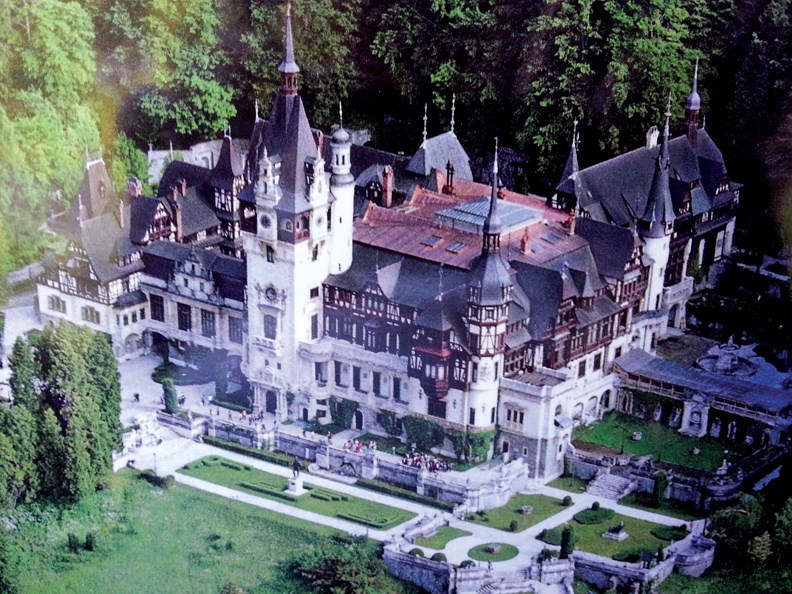Our trip started with the new Pacific Ferries 6:20 a.m. sailing to Coal Harbour. Including the stop in Horseshoe Bay, the trip took just over an hour. We walked to Waterfront Station and were at YVR by 8:15 a.m.
We took the new Air Canada Dreamliner to Montreal, then off on Turkish airlines via Istanbul to Bucharest, where we checked in to the Pullman Hotel about 10 minutes from city centre.
After a hearty breakfast we headed north to Curtea de Arges, the former capital of Wallachia. We visited the Episcopal church where the Romanian kings are buried, then headed north through the picturesque Olt Valley to Cozia Monastery, a 14th century monument with its magnificent collection of icons of glass.
We arrived at Sibiu, one of the oldest cities in Tran-sylvania, formerly known as Hermannstadt, founded by the Saxon colonists. A short walking tour of the Medieval town included the main square, the Evangelical Church and the Liars Bridge. Here we were treated to a visit to the Museum of Icons on Glass. Our accommodation was in a beautiful pension set in the mountains where we were served a lovely local dinner with plenty of wine.
In the morning we headed further north to Sighisoara, birthplace of Vlad the Impaler – Dracula! We travelled through the Unesco town of Beirtan and the fortified church. In Sighisoara we saw the clock tower, the church on the hill, and the house where Dracula was born, now a museum and restaurant. After lunch we travelled on to Targu Mures with a photo stop at the Palace of Culture. Next, on to Cluj Napoca for a walking tour of the city, a great dinner with more wine and an overnight stay.
Next morning we headed to the salt mine at Turda – a magnificent underground complex for extracting salt – surprisingly fascinating. Next, it was off to Maramures, land of wood, where the most authentic rural life can be found. Here we visited traditional villages with their wooden gates and the merry cemetery at Sapanta (on the border with Ukraine). The cemetery chronicles the lives of the local town folk.
After lunch we headed to Sighetu Marmatiei with churches dating from the Austro-Hungarian period.
Our overnight was in the beautiful Gradini Mori II with – you guessed it – more wine!
We headed east into Bucovina County and visited Rozavlea and the Leud Churches, then on to the peasant museum at Dragomiresti, a glimpse of life dating back to 1790. In this house the last occupant (a single woman) would advertise her status by a tree pole decorated with colourful pots and pans (the more pans, the better the catch).
Bucovina is the land of the unique painted monasteries, belonging to the Unesco World Heritage. On to Campulung Moldovenesc and a visit to the wooden museum. We spent two nights in the beautiful town of Gura Humorului.
Next day, we visited the jewel of Bucovina, Voronet Monastery, also called the Sistine Chapel of the East, then on to Monastary Moldovita, another Unesco site, Sucevita Monastery (1585) a beautiful fortress, and the village of Marginea, known for its black pottery.
The beautiful land of Moldavia was next on the agenda, with its typical villages and a visit to the Monastery of Neamt, built during the 14th and 15th centuries. It represents an important cultural centre and its church was an example for all the churches of Moldavia. Next up, the Secu Monastery, then the grand Monastery of Agapia, surrounded by small homes where approximately 200 nuns live. We visited the workshops where the nuns weave carpets and handmade scarfs, hats, and other items.
After lunch we drove along Lake Bicaz then crossed Bicaz Gorge on foot to Red Lake Resort and overnight in Lacu Rosu. Early in the morning, we departed for Brasov (formerly Kronstadt) with a stop en route to Prejmer and the fortified church.
We continued to Bran and the famous castle built for the citizens of Brasov in 1377 in order to defend the city. In 1922 Queen Mary of Romania transformed the castle into her summer residence. Over the years it stood as a Medieval art museum and is best known as Dracula’s castle.
We arrived in Brasov where we had a walking tour of city hall, the Black Church and Hirsch House. Brasov is also known for its great beer.
Next morning, we headed across the Carpathian Mountains and arrived at Azuga for some wine tasting at Halewood Cellars. We continued on to Sinaia, one of the most beautiful mountain resort towns, known as the pearl of the Carpathians. Here we visited the fabulous Peles Castle, the former residence of the royal family with its armoury collection, unique for its richness and diversity, and the highlight of our trip!
Authentic, natural and cultural are the words that best capture the essence of Romania, a dynamic country rich in history, arts and scenic beauty. Romania offers countless unique travel experiences just waiting to be discovered. The Danube River is within three hours of the capital, or take advantage of an extension into Bulgaria. All in all, Romania is well worth a visit, while it’s still relatively undiscovered.



